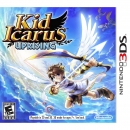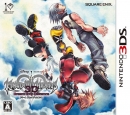My personal game-rating scale isn't "1 to 10". It's "1 to Metroid Prime".
http://www.ign.com/articles/2012/12/06/how-metroid-found-its-prime
How Metroid Found Its Prime
Ten years after its release, we reflect on the emotional highs and lows that led us to Samus Aran's GameCube masterpiece.
The day before Wii U debuted, NOA President Reggie Fils-Aime walked the line of fans outside New York’s Nintendo World Store. He chatted them up, helping them pass a few minutes as they sat, stood and shivered while waiting for the console’s midnight launch. He talked Nintendo. And, perhaps oddly, one game that was brought up in the middle of that interaction was Metroid Prime.
It seemed a bit out of place to mention – after all, the Prime series hasn’t been active for a while, and it’s been a full 10 years since Metroid Prime first arrived for the GameCube. Oh, wait. That’s right. It was exactly 10 years since Metroid Prime was released – its anniversary overlapped precisely with the Wii U launch.
So you’d be forgiven for forgetting to mark that major Metroid milestone yourself, as, like us, you were probably much more concerned with securing your own spot in a Wii U launch line to remember to celebrate our girl Samus. But now that the Wii U’s debut is behind us, we finally have a chance to look back and reflect on what was, arguably, the best game in the Metroid franchise – and the long wait Nintendo fans had to endure to finally play it.
If you were to argue against Metroid Prime’s placement as the best game in this series, you’d likely be taking the side of Super Metroid instead. And understandably so – Super Metroid was absolutely brilliant. The 16-bit installment in Samus’ series was so well crafted, so precisely tuned and so universally loved that even to this day it’s still commonly placed among the top video games of all time in those countdown lists we journalists like to put together from time to time.
Following up a hit like that must have seemed like an impossible task. And, so, Nintendo didn’t even try. Metroid went on hiatus as a series after Super Metroid’s 1994 release, and the brand ultimately disappeared for over eight years before Prime finally brought it back in November 2002. It was one of the longest breaks any of Nintendo’s major brands has ever taken.
The reason Metroid went dark for so long, though, has been revealed to us through the course of time – it’s because Nintendo, for years, just couldn’t settle on what the series’ next step should be. Another 2D adventure? Bringing things into 3D, as with Super Mario 64 and The Legend of Zelda: Ocarina of Time had done? Going another route entirely? The indecision ultimately resulted in the rumored “Metroid 64” never materializing, as Samus ended up missing out on the entire N64 console cycle – with the exception of her appearance in the first Super Smash Bros.
Five months after the stunning debut of Zelda in 3D, though, we finally got word that Metroid had not been forgotten.

Surely, nothing could surpass this adventure. Right?
“Nintendo's Shigeru Miyamoto today confirmed that an internal development team at is working on a Metroid title for a Nintendo console.” That was the opening line in a news post IGN published way back in March of 1999, and it kicked off a season of emotional highs and lows for the Metroid faithful. We were on a high with the revelation that a fourth Metroid was being made.
But then came a low, when the project wasn’t mentioned again by Nintendo for over a year. The next time we got any news at all was at August 2000’s Spaceworld show(remember when that was a thing?), when the Big N confirmed that the then-unnamed Metroid sequel would be coming to the GameCube. Which, at that point, was still itself over a year away from release.
The wait didn’t seem too terrible, though, because the announcement came accompanied by our very first look at the game In action. Or, rather, a 10-second FMV sequence meant to tease the game. Samus appeared in 3D, running down a corridor, pursued by a swarm of alien bugs. She fled the creatures for a few moments, then turned around and opened fire on them.
And that was it. A brief, fleeting glimpse at Metroid being re-imagined into what we could only assume was going to be a new third-person shooter on Nintendo’s next console.

The all-new Samus, circa Spaceworld 2000.
Fans were on another high with the Spaceworld reveal, as the next Metroid game was actually, visibly a work-in-progress now. But, then, the next low came right alongside it – because Nintendo also revealed that the title was no longer being developed internally. Instead, an untested, unknown little studio in Texas had taken over.
Retro Studios is a name now synonymous with quality for Nintendo fans, but in August 2000 they were met with nothing but skepticism. And actually, when I say that Nintendo revealed them as the game’s developer, that isn’t entirely true – they kind of revealed themselves.
Retro ran afoul of Nintendo’s strict secrecy policies and posted a set of job openings on their website, saying “Wanna work for the company rumored to be developing Metroid for Nintendo GameCube?” alongside a 3D render of Samus. It was the kind of event we’d never seen before from a Nintendo second-party, and haven’t seen again since. The oddity of it all just added to fans’ fears, too, that this little outfit in Austin wouldn’t be up to handling a property as revered as Metroid.

The actual ad that appeared on Retro's website. Help wanted!
Nothing could have prepared the Nintendo fandom for what came next, though. Three months after Retro letting the cat out of the bag about being Metroid’s developer, a true firestorm ignited when it was announced that the new sequel would not be in third-person after all – it would, instead, be transformed into a first-person shooter. Angry mobs, pitchforks and torches the likes of which Nintendo had never seen emerged from that bit of news, as fans starting calling for blood and lamenting Samus’ fall to the dark side.
No one could imagine a first-person Metroid being any good. Everyone thought it was doomed from the start. Nintendo tried its best to clarify that the new Metroid would be a “first-person adventure,” and not a standard FPS, but that terminology only confused the masses further.
Then things only got worse, as in July of 2001 the word got out that development was not progressing as planned. Retro was forced to cancel another project in the works – Raven Blade, which would have been a fantasy RPG for GameCube – and refocus all their personnel and energy into bringing Prime up to snuff. “Metroid Prime” was actually known as the name at that point, and fans had some hope that its story – promised to be a prequel – would be a compelling new tale of Samus.
But then insiders who’d played in-progress builds of the game came away so unimpressed that one of them flat-out said the game sucked. Yet another low, low point for Metroid’s fans.

One of the earliest first-person shots of the game in development.
Somehow, some way, through some bit of magic, things turned around. Development got back on track. Things that hadn’t worked began to click. The balance was found between first- and third-person views – as players would step behind Samus’ visor for exploration and combat, but the camera would pull back to allow for Morph Ball mode to function in cramped quarters.
No doubt all of this came about with no small amount of yelling, stern direction and up-ended tea tables from Japanese executives’ visits to Austin, Texas. But, however it happened, Metroid Prime went from looking like a surefire trainwreck to one of Nintendo fans’ most anticipated new titles.
The pendulum had swung so far back in the positive direction, in fact, that IGN began running a series of articles called Prime Time Friday, posting new videos of the game every single week. The series ran for 20 separate installments, leading almost all the way up to Metroid Prime’s arrival on store shelves, 10 years ago.

The cover of August 2002's IGN Unplugged, a digital magazine from yesteryear.
And in the end, all of the chaos and confusion of development, all of the struggles and skepticism and all of the eight full years of waiting was put in the past and forgotten as fans enjoyed the incredible masterpiece that was Metroid Prime. The team at Retro Studios transcended the years of troubles and delivered a stunning, epic re-imagining of Metroid that absolutely worked with a first-person perspective. It perfectly recaptured the feelings of isolation, exploration and discovery that made Super Metroid so memorable – and achieved the impossible by being a true, capable successor to that earlier classic.
You can read our original review of Metroid Prime right here, if you like. We’ve updated it with IGN’s new review formatting, making it look nicer than ever before. I’d also encourage you to walk through our full archive of articles covering MP over the years – it really has been a wild rollercoaster ride with this game. (And, since its release, with its many sequels.)
Yes, it’s important to remember and recognize Metroid Prime, here 10 years after its debut, as waiting for it was, perhaps, the biggest test of patience Nintendo fans have ever had to endure. Much more than simply waiting in a line, sitting and shivering in anticipation of a new console release.
Though that moment will Reggie and the Wii U fans in New York does pose an interesting question, as we close – just why exactly was Metroid Prime at the forefront of the NOA President’s mind? Perhaps Prime’s story isn’t yet done, and we’ll soon see what connection Samus Aran may yet have with the all-new Wii U.
3DS Friend Code: 0645 - 5827 - 5788
WayForward Kickstarter is best kickstarter: http://www.kickstarter.com/projects/1236620800/shantae-half-genie-hero





















